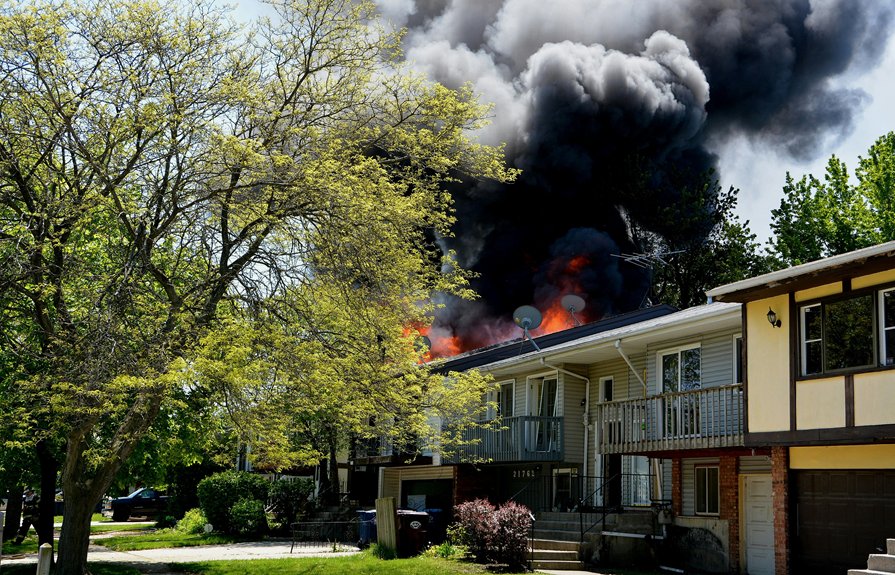When maneuvering insurance claims for roof replacement in Oklahoma City, understanding the region’s weather patterns and local policies becomes essential. Your success hinges on meticulous documentation of storm damage, clear communication with insurers, and familiarity with your policy’s specifics. As you prepare to file your claim, consider the unique challenges posed by Oklahoma’s climate and insurance landscape—factors that can greatly influence your outcome and recovery process.
Understanding Oklahoma City’s Roofing and Insurance Landscape
Oklahoma City’s unique weather patterns and historic architecture greatly influence the local roofing and insurance landscape. You must understand that roofing regulations here are strict, often requiring materials and installation practices that withstand severe weather, like hail and high winds.
Insurance policies are tailored to address these risks, frequently emphasizing coverage for storm damage. It’s essential to review your policy carefully, noting exclusions related to weather-related wear and tear, which are common in Oklahoma City’s climate.
Local building codes also impact roofing standards, ensuring repairs and replacements meet safety criteria. Staying informed about evolving regulations and coverage options helps you navigate claims effectively.
Recognizing how weather influences both roofing requirements and insurance policies positions you to better protect your property and expedite claims processing. For expert assistance with storm damage roof repair and navigating insurance claims, consider contacting Top View Roofing.
Detecting Storm Damage and Documenting It Properly
After understanding the landscape of roofing regulations and insurance considerations, the next step is to accurately identify storm damage to your roof.
Carefully examine your roof for signs such as missing or curled shingles, dented metal, or granule loss. Look for visible impacts like hail dents or cracked flashing, which are common indicators of storm damage.
To guarantee your documentation is thorough, use clear, high-resolution photos from multiple angles, focusing on specific damage points. Employ documentation techniques like timestamped images and detailed notes describing the damage’s location and extent.
Proper documentation not only provides tangible evidence for your insurance claim but also helps prevent disputes. Being meticulous in detecting storm damage and documenting it correctly is critical to establishing the legitimacy of your claim.
Initiating Your Insurance Claim: The First Steps
Once you’ve thoroughly documented the damage to your roof, the next critical step is initiating your insurance claim promptly and methodically.
Start with claim preparation by gathering all relevant evidence, including photos, repair estimates, and a detailed damage report. This guarantees you present a thorough case to your insurer.
Before filing, review your policy carefully to understand coverage limits, deductibles, and specific claim procedures. Accurate policy review helps you avoid surprises and guarantees you meet all requirements.
Contact your insurance company through their designated channels, such as phone or online portal, and provide a clear, organized summary of the damage and your documentation.
Taking these initial steps with attention to detail positions you for a smoother claims process and effective communication with your insurer.
Navigating the Insurance Adjustment Process
As your insurance adjuster begins evaluating your claim, it’s essential to understand that this process involves a detailed review of your documentation, inspection of the damage, and assessment of repair costs.
Insurance adjusters analyze your photos, reports, and estimates to determine coverage scope and payout amounts. During this phase, they may request additional information or schedule inspections to verify damage.
Being prompt and thorough with your documentation can help guarantee claim timelines stay on track. Adjusters follow specific procedures to assess the severity of your roof damage accurately, influencing the final settlement.
Understanding how insurance adjusters evaluate claims allows you to anticipate the process flow and avoid delays, guaranteeing a smoother and more efficient adjustment process.
Common Challenges and How to Overcome Them
Maneuvering insurance claims for roof replacement often presents several challenges that can hinder a smooth resolution.
Claim denials are a common obstacle, often resulting from insufficient damage assessments or misinterpretation of policy coverage. To counter this, you must verify your damage assessments are detailed and well-documented, including detailed photos and expert evaluations.
When faced with a denial, review the insurer’s reasoning carefully and gather supporting evidence to challenge or appeal the decision. Additionally, understanding policy exclusions and coverage limits helps set realistic expectations.
Being proactive in communication and providing clear, thorough documentation strengthens your position. Recognizing these challenges early allows you to implement strategic steps, increasing your chances of a successful claim outcome despite potential setbacks.
Tips for a Successful Roof Replacement Claim
To maximize your chances of a successful roof replacement claim, it’s crucial to prepare thoroughly and present organized, compelling evidence.
Understand the claim types your insurer accepts, such as those for storm damage or wear and tear, and tailor your documentation accordingly.
When evaluating roofing materials, verify your records specify the exact materials used, including manufacturer details and installation dates.
Photographs of the damage, detailed estimates from licensed contractors, and any previous maintenance records bolster your case.
Clearly distinguish between the old and new roofing materials, emphasizing upgrades or material enhancements if applicable.
Demonstrating a thorough understanding of your claim types and roofing materials helps insurers process your claim efficiently and increases the likelihood of full coverage.
Conclusion
Managing insurance claims for roof replacement in Oklahoma City requires careful documentation, thorough understanding of your policy, and proactive communication. By accurately capturing storm damage, knowing your coverage limits, and engaging promptly with your insurer, you increase your chances of a smooth claims process. Staying informed about local weather patterns and regulations helps you anticipate potential hurdles. Ultimately, a detailed, organized approach guarantees your roof repair is justified, covered, and completed efficiently, minimizing stress and maximizing your insurance benefits. For more information on how to schedule your free roof inspection, call us at (405) 543-2920 or visit us online at Top View Roofing.











